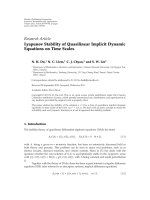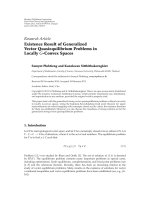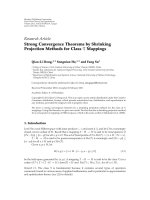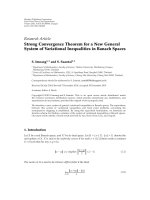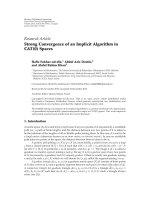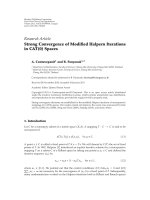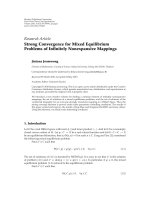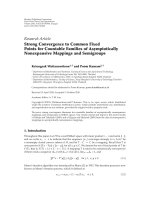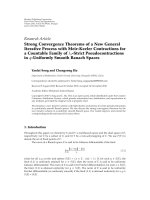Báo cáo hóa học: " Research Article Strong Convergence of Modified Halpern Iterations in CAT(0) Spaces" docx
Bạn đang xem bản rút gọn của tài liệu. Xem và tải ngay bản đầy đủ của tài liệu tại đây (499.53 KB, 11 trang )
Hindawi Publishing Corporation
Fixed Point Theory and Applications
Volume 2011, Article ID 869458, 11 pages
doi:10.1155/2011/869458
Research Article
Strong Convergence of Modified Halpern Iterations
in CAT(0) Spaces
A. Cuntavepanit
1
and B. Panyanak
1, 2
1
Department of Mathematics, Faculty of Science, Chiang Mai University, Chiang Mai 50200, Thailand
2
Materials Science Research Center, Faculty of Science, Chiang Mai University,
Chiang Mai 50200, Thailand
Correspondence should be addressed to B. Panyanak,
Received 28 November 2010; Accepted 10 January 2011
Academic Editor: Qamrul Hasan Ansari
Copyright q 2011 A. Cuntavepanit and B. Panyanak. This is an open access article distributed
under the Creative Commons Attribution License, which permits unrestricted use, distribution,
and reproduction in any medium, provided the original work is properly cited.
Strong convergence theorems are established for the modified Halpern iterations of nonexpansive
mappingsinCAT0 spaces. Our results extend and improve the recent ones announced by Kim
and Xu 2005,Hu2008, Song and Chen 2008,Saejung2010, and many others.
1. Introduction
Let C be a nonempty subset of a metric space X, d. A mapping T : C → C is said to be
nonexpansive if
d
Tx,Ty
≤ d
x, y
, ∀x, y ∈ C. 1.1
Apointx ∈ C is called a fixed point of T if x Tx. We will denote by FT the set of fixed
points of T. In 1967, Halpern 1 introduced an explicit iterative scheme for a nonexpansive
mapping T on a subset C of a Hilbert space by taking any points u, x
1
∈ C and defined the
iterative sequence {x
n
} by
x
n1
α
n
u
1 − α
n
Tx
n
, for n ≥ 1, 1.2
where α
n
∈ 0, 1. He pointed out that the control conditions: C1 lim
n
α
n
0andC2
∞
n1
α
n
∞ are necessary for the convergence of {x
n
} to a fixed point of T. Subsequently,
many mathematicians worked on the Halpern iterations both in Hilbert and Banach spaces
2 Fixed Point Theory and Applications
see, e.g., 2–11 and the references therein. Among other things, Wittmann 7 proved
strong convergence of the Halpern iteration under the control conditions C1, C2,andC4
∞
n1
|α
n1
−α
n
| < ∞ in a Hilbert space. In 2005, Kim and Xu 12 generalized Wittmann’s result
by introducing a modified Halpern iteration in a Banach space as follows. Let C be a closed
convex subset of a uniformly smooth Banach space X,andletT : C → C be a nonexpansive
mapping. For any points u, x
1
∈ C, the sequence {x
n
} is defined by
x
n1
β
n
u
1 − β
n
T
α
n
x
n
1 − α
n
Tx
n
, for n ≥ 1, 1.3
where {α
n
} and {β
n
} are sequences in 0, 1. They proved under the following control
conditions:
D1
lim
n
α
n
0, lim
n
β
n
0,
D2
∞
n1
α
n
∞,
∞
n1
β
n
∞,
D3
∞
n1
|
α
n1
− α
n
|
< ∞,
∞
n1
β
n1
− β
n
< ∞,
1.4
that the sequence {x
n
} converges strongly to a fixed point of T.
The purpose of this paper is to extend Kim-Xu’s result to a special kind of metric
spaces, namely, CAT0 spaces. We also prove a strong convergence theorem for another kind
of modified Halpern iteration defined by Hu 13 in this setting.
2. CAT(0) Spaces
A metric space X is a CAT0 space if it is geodesically connected and if every geodesic
triangle in X is at least as “thin” as its comparison triangle in the Euclidean plane. The precise
definition is given below. It is well known that any complete, simply connected Riemannian
manifold having nonpositive sectional curvature is a CAT0 space. Other examples include
Pre-Hilbert spaces see 14, R-trees see 15, Euclidean buildings see 16, the complex
Hilbert ball with a hyperbolic metric see 17, and many others. For a thorough discussion
of these spaces and of the fundamental role they play in geometry, we refer the reader to
Bridson and Haefliger 14 .
Fixed point theory in CAT0 spaces was first studied by Kirk see 18, 19.He
showed that every nonexpansive single-valued mapping defined on a bounded closed
convex subset of a complete CAT0 space always has a fixed point. Since then, the fixed
point theory for single-valued and multivalued mappings in CAT0 spaces has been rapidly
developed, and many papers have appeared see, e.g., 20–31 and the references therein.It
is worth mentioning that fixed point theorems in CAT0 spaces specially in R-trees can be
applied to graph theory, biology, and computer science
see, e.g., 15, 32–35.
Let X, d be a metric space. A geodesic path joining x ∈ X to y ∈ X or, more briefly, a
geodesic from x to y is a map c from a closed interval 0,l ⊂ R to X such that c0x, cly
and dct,ct
|t − t
| for all t, t
∈ 0,l. In particular, c is an isometry and dx, yl.The
image α of c is called a geodesic or metric segment joining x and y. When it is unique, this
geodesic segment is denoted by x, y. The space X, d is said to be a geodesic space if every
Fixed Point Theory and Applications 3
two points of X are joined by a geodesic, and X is said to be uniquely geodesic if there is
exactly one geodesic joining x and y for each x, y ∈ X.AsubsetY ⊆ X is said to be convex if
Y includes every geodesic segment joining any two of its points.
A geodesic triangle Δx
1
,x
2
,x
3
in a geodesic metric space X, d consists of three points
x
1
,x
2
, and x
3
in X the vertices of Δ and a geodesic segment between each pair of vertices
the edges of Δ.Acomparison triangle for the geodesic triangle Δx
1
,x
2
,x
3
in X, d is a
triangle
Δx
1
,x
2
,x
3
:Δx
1
, x
2
, x
3
in the Euclidean plane E
2
such that d
E
2
x
i
, x
j
dx
i
,x
j
for i, j ∈{1, 2, 3}.
A geodesic space is said to be a CAT0 space if all geodesic triangles satisfy the
following comparison axiom.
CAT0:letΔ be a geodesic triangle in X,andlet
Δ be a comparison triangle for Δ.
Then, Δ is said to satisfy the CAT0 inequality if for all x, y ∈ Δ and all comparison points
x, y ∈ Δ,
d
x, y
≤ d
E
2
x, y
. 2.1
Let x, y ∈ X, and by Lemma 2.1 iv of 23 for each t ∈ 0, 1, there exists a unique
point z ∈ x, y such that
d
x, z
td
x, y
,d
y, z
1 − t
d
x, y
. 2.2
From now on, we will use the notation 1 − tx ⊕ ty for the unique point z satisfying 2.2.We
now collect some elementary facts about CAT0 spaces which will be used in the proofs of
our main results.
Lemma 2.1. Let X be a CAT0 space. Then,
i (see [23, Lemma 2.4]) for each x, y, z ∈ X
and t ∈ 0, 1, one has
d
1 − t
x ⊕ ty, z
≤
1 − t
d
x, z
td
y, z
, 2.3
ii (see [21]) for each x, y ∈ X and t, s ∈ 0, 1, one has
d
1 − t
x ⊕ ty,
1 − s
x ⊕ sy
|
t − s
|
d
x, y
, 2.4
iii (see [19, Lemma 3]) for each x, y, z ∈ X and t
∈ 0, 1, one has
d
1 − t
z ⊕ tx,
1 − t
z ⊕ ty
≤ td
x, y
, 2.5
iv (see [23, Lemma 2.5]) for each x, y, z ∈ X and t ∈ 0, 1, one has
d
1 − t
x ⊕ ty, z
2
≤
1 − t
d
x, z
2
td
y, z
2
− t
1 − t
d
x, y
2
.
2.6
Recall that a continuous linear functional μ on
∞
, the Banach space of bounded real
sequences, is called a Banach limit if μ μ1, 1, 1andμ
n
a
n
μ
n
a
n1
for all {a
n
}∈
∞
.
4 Fixed Point Theory and Applications
Lemma 2.2 see 8,Proposition 2. Let {a
1
,a
2
, }∈
∞
be such that μ
n
a
n
≤ 0 for all Banach
limits μ and lim sup
n
a
n1
− a
n
≤ 0. Then, lim sup
n
a
n
≤ 0.
Lemma 2.3 see 28, Lemma 2.1. Let C be a closed convex subset of a complete CAT0 space X,
and let T : C → C be a nonexpansive mapping. Let u ∈ C be fixed. For each t ∈ 0, 1, the mapping
S
t
: C → C defined by
S
t
z tu ⊕
1 − t
Tz, for z ∈ C 2.7
has a unique fixed point z
t
∈ C, that is,
z
t
S
t
z
t
tu ⊕
1 − t
T
z
t
. 2.8
Lemma 2.4 see 28, Lemma 2.2. Let C and T be as the preceding lemma. Then, FT
/
∅ if and
only if {z
t
} given by 2.8 remains bounded as t → 0. In this case, the following statements hold:
1 {z
t
} converges to the unique fixed point z of T which is nearest u,
2 d
2
u, z ≤ μ
n
d
2
u, x
n
for all Banach limits μ and all bounded sequences {x
n
} with
lim
n
dx
n
,Tx
n
0.
Lemma 2.5 see 10, Lemma 2.1. Let {α
n
}
∞
n1
be a sequence of nonnegative real numbers
satisfying the condition
α
n1
≤
1 − γ
n
α
n
γ
n
σ
n
,n≥ 1, 2.9
where {γ
n
} and {σ
n
} are sequences of real numbers such that
1{γ
n
}⊂0, 1 and
∞
n1
γ
n
∞,
2 either lim sup
n →∞
σ
n
≤ 0 or
∞
n1
|γ
n
σ
n
| < ∞.
Then, lim
n →∞
α
n
0.
Lemma 2.6 see 27, 36. Let {x
n
} and {y
n
} be bounded sequences in a CAT0 space X, and let
{α
n
} be a sequence in 0, 1 with 0 < lim inf
n
α
n
≤ lim sup
n
α
n
< 1. Suppose that x
n1
α
n
y
n
⊕ 1 −
α
n
x
n
for all n ∈ N and
lim sup
n →∞
d
y
n1
,y
n
− d
x
n1
,x
n
≤ 0.
2.10
Then, lim
n
dx
n
,y
n
0.
3. Main Results
The following result is an analog of Theorem 1 of Kim and Xu 12. They prove the theorem
by using the concept of duality mapping, while we use the concept of Banach limit. We also
observe that the condition
∞
n1
α
n
∞ in 12, Theorem 1 is superfluous.
Fixed Point Theory and Applications 5
Theorem 3.1. Let C be a nonempty closed convex subset of a complete CAT0 space X, and let
T : C → C be a nonexpansive mapping such that FT
/
∅. Given a point u ∈ C and sequences {α
n
}
and {β
n
} in 0, 1, the following conditions are satisfied:
(A1) lim
n
α
n
0 and
∞
n1
|α
n1
− α
n
| < ∞,
(A2) lim
n
β
n
0,
∞
n1
β
n
∞ and
∞
n1
|β
n1
− β
n
| < ∞.
Define a sequence {x
n
} in C by x
1
x ∈ C arbitrarily, and
x
n1
β
n
u ⊕
1 − β
n
α
n
x
n
⊕
1 − α
n
Tx
n
, ∀n ≥ 1. 3.1
Then, {x
n
} converges to a fixed point z ∈ FT which is nearest u.
Proof. For each n ≥ 1, we let y
n
: α
n
x
n
⊕ 1 − α
n
Tx
n
. We divide the proof into 3 steps.
i We will show that {x
n
}, {y
n
},and{Tx
n
} are bounded sequences. ii We show that
lim
n
dx
n
,Tx
n
0. Finally, we show that iii {x
n
} converges to a fixed point z ∈ FT which
is nearest u.
i As in the first part of the proof of 12, Theorem 1, we can show that {x
n
} is
bounded and so is {y
n
} and {Tx
n
}. Notice also that
d
y
n
,p
≤ d
x
n
,p
, ∀p ∈ F
T
. 3.2
ii It suffices to show that
lim
n →∞
d
x
n
,x
n1
0.
3.3
Indeed, if 3.3 holds, we obtain
d
x
n
,Tx
n
≤ d
x
n
,x
n1
d
x
n1
,y
n
d
y
n
,Tx
n
d
x
n
,x
n1
d
β
n
u ⊕
1 − β
n
y
n
,y
n
d
α
n
x
n
⊕
1 − α
n
Tx
n
,Tx
n
≤ d
x
n
,x
n1
β
n
d
u, y
n
α
n
d
x
n
,Tx
n
−→ 0, as n −→ ∞ .
3.4
By using Lemma 2.1 ,weget
d
x
n1
,x
n
d
β
n
u ⊕
1 − β
n
y
n
,β
n−1
u ⊕
1 − β
n−1
y
n−1
≤ d
β
n
u ⊕
1 − β
n
y
n
,β
n
u ⊕
1 − β
n
y
n−1
d
β
n
u ⊕
1 − β
n
y
n−1
,β
n−1
u ⊕
1 − β
n−1
y
n−1
6 Fixed Point Theory and Applications
≤
1 − β
n
d
y
n
,y
n−1
β
n
− β
n−1
d
u, y
n−1
1 − β
n
d
α
n
x
n
⊕
1 − α
n
Tx
n
,α
n−1
x
n−1
⊕
1 − α
n−1
Tx
n−1
β
n
− β
n−1
d
u, α
n−1
x
n−1
⊕
1 − α
n−1
Tx
n−1
≤
1 − β
n
d
α
n
x
n
⊕
1 − α
n
Tx
n
,α
n
x
n−1
⊕
1 − α
n
Tx
n
d
α
n
x
n−1
⊕
1 − α
n
Tx
n
,α
n
x
n−1
⊕
1 − α
n
Tx
n−1
d
α
n
x
n−1
⊕
1 − α
n
Tx
n−1
,α
n−1
x
n−1
⊕
1 − α
n−1
Tx
n−1
β
n
− β
n−1
α
n−1
d
u, x
n−1
1 − α
n−1
d
u, Tx
n−1
≤
1 − β
n
α
n
d
x
n
,x
n−1
1 − α
n
d
Tx
n
,Tx
n−1
|
α
n
− α
n−1
|
d
x
n−1
,Tx
n−1
β
n
− β
n−1
α
n−1
d
u, x
n−1
1 − α
n−1
d
u, Tx
n−1
1 − β
n
d
x
n
,x
n−1
1 − β
n
|
α
n
− α
n−1
|
d
x
n−1
,Tx
n−1
β
n
− β
n−1
α
n−1
d
u, x
n−1
β
n
− β
n−1
1 − α
n−1
d
u, Tx
n−1
≤
1 − β
n
d
x
n
,x
n−1
1 − β
n
|
α
n
− α
n−1
|
d
x
n−1
,Tx
n−1
β
n
− β
n−1
α
n−1
d
u, Tx
n−1
d
Tx
n−1
,x
n−1
β
n
− β
n−1
d
u, Tx
n−1
−
β
n
− β
n−1
α
n−1
d
u, Tx
n−1
1 − β
n
d
x
n
,x
n−1
1 − β
n
|
α
n
− α
n−1
|
d
x
n−1
,Tx
n−1
β
n
− β
n−1
α
n−1
d
x
n−1
,Tx
n−1
β
n
− β
n−1
d
u, Tx
n−1
.
3.5
Hence,
d
x
n1
,x
n
≤
1 − β
n
d
x
n
,x
n−1
γ
|
α
n
− α
n−1
|
2
β
n
− β
n−1
, 3.6
where γ>0 is a constant such that γ ≥ max{du, Tx
n−1
,dx
n−1
,Tx
n−1
} for all n ∈ N.By
assumptions, we have
lim
n →∞
β
n
0,
∞
n1
β
n
∞,
∞
n1
|
α
n
− α
n−1
|
2
β
n
− β
n−1
< ∞.
3.7
Hence, Lemma 2.5 is applicable to 3.6, and we obtain lim
n
dx
n1
,x
n
0.
Fixed Point Theory and Applications 7
iii From Lemma 2.3,letz lim
t → 0
z
t
, where z
t
is given by 2.8. Then, z is the point
of FT which is nearest u. We observe that
d
2
x
n1
,z
d
2
β
n
u ⊕
1 − β
n
y
n
,z
≤ β
n
d
2
u, z
1 − β
n
d
2
y
n
,z
− β
n
1 − β
n
d
2
u, y
n
≤ β
n
d
2
u, z
1 − β
n
d
2
x
n
,z
− β
n
1 − β
n
d
2
u, y
n
1 − β
n
d
2
x
n
,z
β
n
d
2
u, z
−
1 − β
n
d
2
u, y
n
.
3.8
By Lemma 2.4, we have μ
n
d
2
u, z − d
2
u, x
n
≤ 0 for all Banach limit μ. Moreover, since
lim
n
dx
n1
,x
n
0,
lim sup
n →∞
d
2
u, z
− d
2
u, x
n1
−
d
2
u, z
− d
2
u, x
n
0.
3.9
It follows from lim
n
dy
n
,x
n
0andLemma 2.2 that
lim sup
n →∞
d
2
u, z
−
1 − β
n
d
2
u, y
n
lim sup
n →∞
d
2
u, z
− d
2
u, x
n
≤ 0.
3.10
Hence, the conclusion follows from Lemma 2.5.
By using the similar technique as in the proof of Theorem 3.1, we can obtain a
strong convergence theorem which is an analog of 13, Theorem 3.1see also 37, 38 for
subsequence comments.
Theorem 3.2. Let C be a nonempty closed and convex subset of a complete CAT0 space X, and let
T : C → C be a nonexpansive mapping such that FT
/
∅. Given a point u ∈ C and an initial value
x
1
∈ C. The sequence {x
n
} is defined iteratively by
x
n1
β
n
x
n
⊕
1 − β
n
α
n
u ⊕
1 − α
n
Tx
n
,n≥ 1. 3.11
Suppose that both {α
n
} and {β
n
} are sequences in 0, 1 satisfying
(B1) lim
n →∞
α
n
0,
(B2)
∞
n1
α
n
∞,
(B3) 0 < lim inf
n →∞
β
n
≤ lim sup
n →∞
β
n
< 1.
Then, {x
n
} converges to a fixed point z ∈ FT which is nearest u.
8 Fixed Point Theory and Applications
Proof. Let y
n
: α
n
u ⊕ 1 − α
n
Tx
n
. We divide the proof into 3 steps.
Step 1. We show that {x
n
}, {y
n
},and{Tx
n
} are bounded sequences. Let p ∈ FT, then we
have
d
x
n1
,p
d
β
n
x
n
⊕
1 − β
n
α
n
u ⊕
1 − α
n
Tx
n
,p
≤ β
n
d
x
n
,p
1 − β
n
d
α
n
u ⊕
1 − α
n
Tx
n
,p
≤ β
n
d
x
n
,p
1 − β
n
α
n
d
u, p
1 − β
n
1 − α
n
d
Tx
n
,p
≤
β
n
1 − β
n
1 − α
n
d
x
n
,p
1 − β
n
α
n
d
u, p
1 −
1 − β
n
α
n
d
x
n
,p
1 − β
n
α
n
d
u, p
≤ max
d
x
n
,p
,d
u, p
.
3.12
Now, an induction yields
d
x
n1
,p
≤ max
d
x
1
,p
,d
u, p
,n≥ 1. 3.13
Hence, {x
n
} is bounded and so are {y
n
} and {Tx
n
}.
Step 2. We show that lim
n
dx
n
,Tx
n
0. By using Lemma 2.1,weget
d
y
n1
,y
n
d
α
n1
u ⊕
1 − α
n1
Tx
n1
,α
n
u ⊕
1 − α
n
Tx
n
≤ α
n
d
α
n1
u ⊕
1 − α
n1
Tx
n1
,u
1 − α
n
d
α
n1
u ⊕
1 − α
n1
Tx
n1
,Tx
n
≤ α
n
1 − α
n1
d
Tx
n1
,u
1 − α
n
α
n1
d
u, Tx
n
1 − α
n
1 − α
n1
d
Tx
n1
,Tx
n
≤ α
n
1 − α
n1
d
Tx
n1
,u
1 − α
n
α
n1
d
u, Tx
n
1 − α
n
1 − α
n1
d
x
n1
,x
n
.
3.14
This implies that
d
y
n1
,y
n
− d
x
n1
,x
n
≤ α
n
1 − α
n1
d
Tx
n1
,u
1 − α
n
α
n1
d
u, Tx
n
α
n
α
n1
− α
n
− α
n1
d
x
n1
,x
n
.
3.15
Since {x
n
} and {Tx
n
} are bounded and lim
n →∞
α
n
0, it follows that
lim sup
n →∞
d
y
n1
,y
n
− d
x
n1
,x
n
≤ 0.
3.16
Fixed Point Theory and Applications 9
Hence, by Lemma 2.6,weget
lim
n →∞
d
x
n
,y
n
0.
3.17
On the other hand,
d
y
n
,Tx
n
d
α
n
u ⊕
1 − α
n
Tx
n
,Tx
n
≤ α
n
d
u, Tx
n
−→ 0, as n −→ ∞ . 3.18
Using 3.17 and 3.18,weget
d
x
n
,Tx
n
≤ d
x
n
,y
n
d
y
n
,Tx
n
−→ 0, as n −→ ∞ . 3.19
Step 3. We show that {x
n
} converges to a fixed point of T.Letz lim
t → 0
z
t
, where z
t
is given
by 2.8, then z ∈ FT. Finally, we show that lim
n
x
n
z
d
2
x
n1
,z
d
2
β
n
x
n
⊕
1 − β
n
y
n
,z
≤ β
n
d
2
x
n
,z
1 − β
n
d
2
y
n
,z
− β
n
1 − β
n
d
2
x
n
,y
n
≤ β
n
d
2
x
n
,z
1 − β
n
d
2
α
n
u ⊕
1 − α
n
Tx
n
,z
− β
n
1 − β
n
d
2
x
n
,y
n
≤
1 − β
n
α
n
d
2
u, z
1 − α
n
d
2
Tx
n
,z
− α
n
1 − α
n
d
2
u, Tx
n
− β
n
1 − β
n
d
2
x
n
,y
n
β
n
d
2
x
n
,z
≤
β
n
1 − β
n
1 − α
n
d
2
x
n
,z
1 − β
n
α
n
d
2
u, z
−
1 − α
n
d
2
u, Tx
n
1 −
1 − β
n
α
n
d
2
x
n
,z
1 − β
n
α
n
d
2
u, z
−
1 − α
n
d
2
u, Tx
n
.
3.20
By Lemma 2.4, we have μ
n
d
2
u, z − d
2
u, x
n
≤ 0 for all Banach limit μ. Moreover, since
d
x
n1
,x
n
d
β
n
x
n
⊕
1 − β
n
y
n
,x
n
≤
1 − β
n
d
y
n
,x
n
−→ 0, as n −→ ∞ ,
lim sup
n →∞
d
2
u, z
d
2
u, x
n1
− d
2
u, z
− d
2
u, x
n
0,
3.21
it follows from condition B1, lim
n
dx
n
,Tx
n
0andLemma 2.2 that
lim sup
n →∞
d
2
u, z
−
1 − α
n
d
2
u, Tx
n
lim sup
n →∞
d
2
u, z
− d
2
u, x
n
≤ 0.
3.22
Hence, the conclusion follows by Lemma 2.5.
10 Fixed Point Theory and Applications
Acknowledgments
The authors are grateful to Professor Sompong Dhompongsa for his suggestions and advices
during the preparation of the paper. This research was supported by the National Research
University Project under Thailand’s Office of the Higher Education Commission.
References
1 B. Halpern, “Fixed points of nonexpanding maps,” Bulletin of the American Mathematical Society, vol.
73, pp. 957–961, 1967.
2 S. Reich, “Some fixed point problems,” Atti della Accademia Nazionale dei Lincei, vol. 57, no. 3-4, pp.
194–198, 1974.
3 P L. Lions, “Approximation de points fixes de contractions,” Comptes Rendus de l’Acad
´
emie des Sciences
de Paris A-B, vol. 284, no. 21, pp. A1357–A1359, 1977 French.
4 S. Reich, “Strong convergence theorems for resolvents of accretive operators in Banach spaces,”
Journal of Mathematical Analysis and Applications, vol. 75, no. 1, pp. 287–292, 1980.
5 S. Reich, “Some problems and results in fixed point theory,” in Topological Methods in Nonlinear
Functional Analysis (Toronto, Ont., 1982),vol.21ofContemporary Mathematics, pp. 179–187, American
Mathematical Society, Providence, RI, USA, 1983.
6 W. Takahashi and Y. Ueda, “On Reich’s strong convergence theorems for resolvents of accretive
operators,” Journal of Mathematical Analysis and Applications, vol. 104, no. 2, pp. 546–553, 1984.
7 R. Wittmann, “Approximation of fixed points of nonexpansive mappings,” Archiv der Mathematik, vol.
58, no. 5, pp. 486–491, 1992.
8 N. Shioji and W. Takahashi, “Strong convergence of approximated sequences for nonexpansive
mappings in Banach spaces,” Proceedings of the American Mathematical Society, vol. 125, no. 12, pp.
3641–3645, 1997.
9 H K. Xu, “Iterative algorithms for nonlinear operators,” Journal of the London Mathematical Society.
Second Series, vol. 66, no. 1, pp. 240–256, 2002.
10 H K. Xu, “An iterative approach to quadratic optimization,” Journal of Optimization Theory and
Applications, vol. 116, no. 3, pp. 659–678, 2003.
11 H K. Xu, “A strong convergence theorem for contraction semigroups in Banach spaces,” Bulletin of
the Australian Mathematical Society, vol. 72, no. 3, pp. 371–379, 2005.
12 T H. Kim and H K. Xu, “Strong convergence of modified Mann iterations,” Nonlinear Analysis:
Theory, Methods & Applications, vol. 61, no. 1-2, pp. 51–60, 2005.
13 L G. Hu, “Strong convergence of a modified Halpern’s iteration for nonexpansive mappings,” Fixed
Point Theory and Applications, vol. 2008, Article ID 649162, 9 pages, 2008.
14 M. R. Bridson and A. Haefliger, Metric Spaces of Non-Positive Curvature, vol. 319 of Grundlehren der
Mathematischen Wissenschaften, Springer, Berlin, Germany, 1999.
15 W. A. Kirk, “Fixed point theorems in CAT0 spaces and
R-trees,” Fixed Point Theory and Applications,
vol. 2004, no. 4, pp. 309–316, 2004.
16 K. S. Brown, Buildings, Springer, New York, NY, USA, 1989.
17 K. Goebel and S. Reich, Uniform Convexity, Hyperbolic Geometry, and Nonexpansive Mappings, vol. 83 of
Monographs and Textbooks in Pure and Applied Mathematics, Marcel Dekker Inc., New York, NY, USA,
1984.
18 W. A. Kirk, “Geodesic geometry and fixed point theory,” in Seminar of Mathematical Analysis
(Malaga/Seville, 2002/2003), vol. 64 of Colecci
´
on Abierta, pp. 195–225, University of Seville, Secretary
of Publications, Seville, Spain, 2003.
19 W. A. Kirk, “Geodesic geometry and fixed point theory. II,” in International Conference on Fixed Point
Theory and Applications, pp. 113–142, Yokohama Publishers, Yokohama, Japan, 2004.
20 S. Dhompongsa, A. Kaewkhao, and B. Panyanak, “Lim’s theorems for multivalued mappings in
CAT0 spaces,” Journal of Mathematical Analysis and Applications, vol. 312, no. 2, pp. 478–487, 2005.
21 P. Chaoha and A. Phon-on, “A note on fixed point sets in CAT0 spaces,” Journal of Mathematical
Analysis and Applications, vol. 320, no. 2, pp. 983–987, 2006.
22 L. Leustean, “A quadratic rate of asymptotic regularity for CAT0-spaces,” Journal of Mathematical
Analysis and Applications, vol. 325, no. 1, pp. 386–399, 2007.
23 S. Dhompongsa and B. Panyanak, “On Δ-convergence theorems in CAT0 spaces,” Computers &
Mathematics with Applications, vol. 56, no. 10, pp. 2572–2579, 2008.
Fixed Point Theory and Applications 11
24 N. Shahzad, “Fixed point results for multimaps in CAT0 spaces,” Topology and Its Applications, vol.
156, no. 5, pp. 997–1001, 2009.
25 R. Espinola and A. Fernandez-Leon, “CATk-spaces, weak convergence and fixed points,” Journal of
Mathematical Analysis and Applications, vol. 353, no. 1, pp. 410–427, 2009.
26 N. Hussain and M. A. Khamsi, “On asymptotic pointwise contractions in metric spaces,” Nonlinear
Analysis: Theory, Methods & Applications, vol. 71, no. 10, pp. 4423–4429, 2009.
27 W. Laowang and B. Panyanak, “Strong and Δ convergence theorems for multivalued mappings in
CAT0 spaces,” Journal of Inequalities and Applications, vol. 2009, Article ID 730132, 16 pages, 2009.
28 S. Saejung, “Halpern’s iteration in CAT0 spaces,” Fixed Point Theory and Applications, vol. 2010,
Article ID 471781, 13 pages, 2010.
29 A. R. Khan, M. A. Khamsi, and H. Fukhar-Ud-Din, “Strong convergence of a general iteration scheme
in CAT0 spaces,” Nonlinear Analysis: Theory, Methods and Applications, vol. 74, no. 3, pp. 783–791,
2011.
30 S. H. Khan and M. Abbas, “Strong and Δ-convergence of some iterative schemes in CAT0 spaces,”
Computers and Mathematics with Applications, vol. 61, no. 1, pp. 109–116, 2011.
31 A. Abkar and M. Eslamian, “Common fixed point results in CAT0 spaces,” Nonlinear Analysis:
Theory, Methods and Applications, vol. 74, no. 5, pp. 1835–1840, 2011.
32 M. Bestvina, “
R-trees in topology, geometry, and group theory,” in Handbook of Geometric Topology, pp.
55–91, North-Holland, Amsterdam, The Netherlands, 2002.
33 C. Semple and M. Steel, Phylogenetics,vol.24ofOxford Lecture Series in Mathematics and Its Applications,
Oxford University Press, Oxford, UK, 2003.
34 R. Espinola and W. A. Kirk, “Fixed point theorems in
R-trees with applications to graph theory,”
Topology and Its Applications, vol. 153, no. 7, pp. 1046–1055, 2006.
35 W. A. Kirk, “Some recent results in metric fixed point theory,” Journal of Fixed Point Theory and
Applications, vol. 2, no. 2, pp. 195–207, 2007.
36 T. Suzuki, “Strong convergence theorems for infinite families of nonexpansive mappings in general
Banach spaces,” Fixed Point Theory and Applications, vol. 2005, no. 1, pp. 103–123, 2005.
37 Y. Song and R. Chen, “Strong convergence of an iterative method for non-expansive mappings,”
Mathematische Nachrichten, vol. 281, no. 8, pp. 1196–1204, 2008.
38 S. Wang, “A note on strong convergence of a modified Halpern’s iteration for nonexpansive
mappings,” Fixed Point Theory and Applications, vol. 2010, Article ID 805326, 2 pages, 2010.
